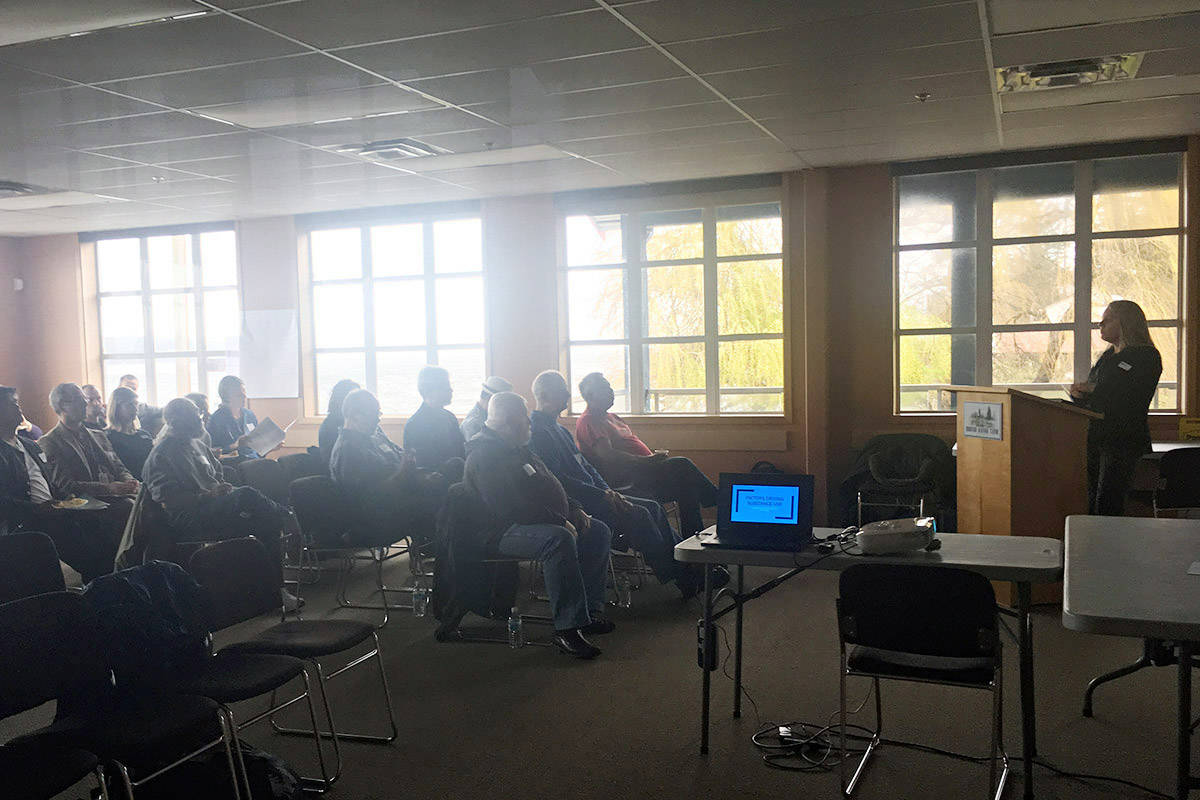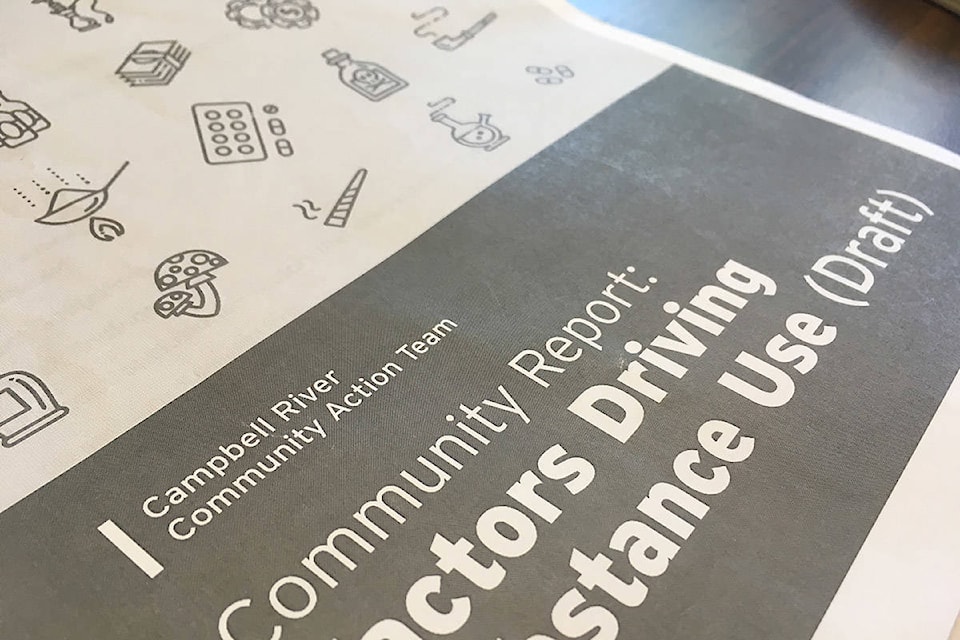A newly drafted report about the drivers of substance use in Campbell River sketches the history of a rugged frontier town that has seen waves of drugs appear alongside booms and busts in the city’s resource-based economy.
Campbell River’s Community Action Team, or CAT – which brings together various groups fighting the opioid crisis – commissioned the report to understand the root causes of substance use.
The group met on April 18 to discuss the findings, and to gather feedback for a final report that will include recommendations about how to tackle the crisis.
The report notes that 80 per cent of opioid users who access medical services for overdoses in Campbell River are men who tend to be Caucasian, employed in the trades and generally use substances at home.
The report says fatalities peaked in 2017 with 37 fatal overdoses on the North Island, including 18 in Campbell River.
Only four other communities had a higher incidence of fatal overdoses – Victoria, Vancouver, Surrey and Kelowna – all of them major urban centres.
This raised the question of what makes Campbell River different from other small cities or nearby communities like the Comox Valley.
The research was based on interviews and focus groups with 37 people, who are quoted anonymously in the 20-page report, including people in recovery, health care professionals, and representatives of First Nations, industry and police.
READ MORE: Community invited to discuss root causes of drug use in Campbell River
The report notes that Campbell River was known historically “as being a last stop, or a frontier town.” Passenger railway service to the South Island ended in Courtenay, meaning that getting to Campbell River required more effort.
This relative isolation, and especially the lack of other leisure and entertainment activities, may have “created the conditions for increased use of substances to flourish.”
One participant in the study recalled arriving in Campbell River in the 1950s: “There was a pulp mill, a couple of mines, a large fishing fleet. More or less everybody had a cigarette in one hand and a bottle of whiskey in the other.”
The city today is a hub for smaller North Island communities, such as Gold River and Zeballos. Several overdose victims in recent years were visitors from those remote communities, where residents “may not receive harm reduction messaging, or may be too trusting of their dealer,” one source said.
Organized crime networks bring drugs into the city through its largely unpatrolled coastline, according to some sources.
“Nearly all participants mentioned the geography of Campbell River, with longtime residents in particular acknowledging the coastline and the role of the ocean in drug trafficking,” the report says.
Fluctuations of the resource-based economy have also influenced drug use, with the prosperous 1970s and 1980s seeing an upsurge in cocaine among high-earners, according to some participants in the study.
“There are two Campbell Rivers: the boom and bust,” one said. “Boom brings hard, expensive and designer drugs. Bust brings about the need for cheaper drugs, like meth.”
Economic downturns in forestry, along with the closure of local mines and the Elk Falls pulp and paper mill, led to more people looking outside of the community for work.
Mental health and medical professionals said that economic hardship led to stress and a “need to cope with change.”
The report stops short of claiming a direct cause-and-effect relationship between economic problems and the opioid crisis.
But one source said, “There’s a lot of people that live under the bread line here… Renting is very expensive and not available and more and more people are getting into trouble with finances, which drives drug use.”
VIDEO: Mobile harm reduction team on the road to fight overdose crisis in Campbell River
The arrival of heroin in the 1970s and 1990s resulted in a significant push-back, residents said, including a “strong urging from the community that law enforcement concentrate on getting illicit substances out of the city.”
That same sentiment doesn’t exist today, sources said, despite a spike in crystal meth and heroin cut with deadly fentanyl and carfentanil.
A major focus of the report is the high number of people working in resource industries and the skilled trades.
Roughly 22 per cent of workers in Campbell River are employed in agriculture, forestry, hunting and fishing, mining, quarrying, oil and gas extraction, utilities and construction, compared to just 12.5 per cent of residents province-wide, according to the report.
Workers may become addicted to prescription opiates after suffering an injury in these physically-demanding and sometimes risky jobs.
These male-dominated occupations are often located in remote locations where there are few options for entertainment, and workers often use drugs and alcohol after returning from weeks-long stints in the bush.
In Campbell River, 11 per cent of working people are employed outside of the community, compared to 5.4 per cent province-wide, according to the report.
The report says that a “lack of cohesion” among various groups, ranging from police to health care workers, hobbles the overall response to the overdose crisis.
“Most respondents spoke of the burden that the entire system is under, noting that even if an individual would like help with their substance use… there are usually many hoops to jump through and a long waiting list.”
One source noted that someone with a broken arm goes through a clear process in the health care system: “We assess you, we take X-rays, we set the arm, and we liaise with your family doctor for follow-up and ongoing care.”
But if someone comes to the emergency room with a substance use problem, “There is no such clear process.”
The final major driver of substance use listed in the report is trauma, particularly among Indigenous people, with examples including colonization, residential schools and ongoing high rates of child apprehension.
VIDEO: Colonial trauma creates drug addiction
Indigenous people represent 13 per cent of Campbell River’s population, compared to just 5.9 per cent B.C.-wide and in the Comox Valley.
“Given this statistic, there is a much higher proportion of Indigenous people in Campbell River who may have experienced one or more of the traumas listed above,” the report says, noting that trauma isn’t exclusive to Indigenous communities.
Statistics released in 2017 by the province and the First Nations Health Authority indicate that Indigenous people are five times more likely to overdose in B.C., and three times more likely to die of an overdose.
Participants in the CAT study stressed the importance of empathy in dealing with the opioid crisis.
“Shaming and blaming people who use substances does not work.”
CAT coordinator Allan Campbell, who carried out the research with Maggie Hodge Kwan, a contractor who authored the report, says it will be released online after being finalized with recommendations.

